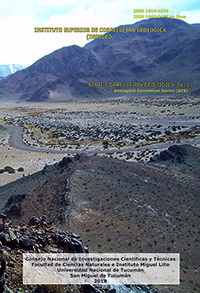Serie Correlación Geológica 34 (1)
Sierra Bachicha: propuesta para un nuevo sitio de interés geológico rural en el partido de Balcarce, provincia de Buenos Aires.
Mariana A. Camino | Karen Halpern | María Juliana Bó | Facundo R. Meroi Arcerito
Descargar trabajo en formato PDFResumen
En la provincia de Buenos Aires la geodiversidad presente contrasta con la escasez de áreas protegidas, teniendo en cuenta su alto valor patrimonial de carácter geológico. Estas características exponen la necesidad de promover el desarrollo de parques geológicos ya que, aún no existe ninguno en la región. Es así que cobran importancia la identificación y valoración de sitios de relevancia geológica, base necesaria para la generación de dichas áreas protegidas. En esta contribución, se describe un nuevo geositio cuyo interés geológico radica en presentar el perfil estratigráfico más completo a escala local. El mismo está ubicado en la zona rural del partido de Balcarce, más precisamente en el faldeo austral de la Sierra Bachicha, donde se encuentra la Cantera San Justo. Este geositio presenta una excelente accesibilidad por estar ubicado sobre la Ruta Nacional 226, y tiene la potencialidad de relacionarse con otros circuitos y sitios de interés geológicos tanto urbanos como periurbanos circundantes, teniendo en cuenta que todos ellos están comunicados por una red vial. La cantera San Justo posee una superficie de 100 ha con 7 pasivos ambientales de origen minero, que dejaron expuestos perfiles estratigráficos que permiten apreciar las rocas más características de la zona y conformar un recurso didáctico para comprender la historia geológica regional y las geoformas del paisaje. Transitar por estos antiguos laboreos, aporta también un componente identitario ya que la actividad minera tiene una impronta muy importante en la historia económica de Balcarce. Visitarlo es posible por la existencia de pistas que conectan las distintas canteras abandonadas. En el presente estudio se propone establecer un recorrido que cronológicamente permitirá contar la historia geológica a escala local/regional, con las recomendaciones establecidas para su implementación.
Abstract
SIERRA BACHICHA: PROPOSAL FOR A NEW SITE OF GEOLOGICAL INTEREST IN THE BALCARCE DISTRICT, PROVINCE OF BUENOS AIRES. In Buenos Aires province, the existing geodiversity contrasts with the scarcity of protected areas in this region, considering its high geoheritage value.
These characteristics expose the necessity to promote the development of geological parks since are established in the geographic area. Thus, the identification and valuation of sites of geological relevance, basic for the generation of the namely protected areas, become important. In this contribution, a new geosite is described whose geological interest lies in presenting the most complete stratigraphic profile at the local scale. It is located in the rural area of Balcarce, more precisely in the southern part of the Sierra Bachicha, where the San Justo Quarry is located. This geosite has excellent accessibility because it is located on National Route 226, and has the potential to be included in other geocircuits and can be related to urban and periurban nearby geosites, taking into account that all of them are connected by a road network. The San Justo quarry has an area of 100 ha with 7 environmental liabilities of mining origin, which left exposed stratigraphic profiles that allow to appreciate the most characteristic rocks of the area and constitute a didactic resource to comprehend the regional geological history and the geoforms of the landscape. Transiting through these old abandoned quarries, also contributes the locals’ identity since the mining activity has a very important imprint in the economic history of Balcarce. Visiting it, it is possible due to the existence of tracks that unite the different quarries. In the present study it is proposed to establish a path that chronologically will allow telling the geological history at a local / regional scale, with the recommendations established for its implementation.






